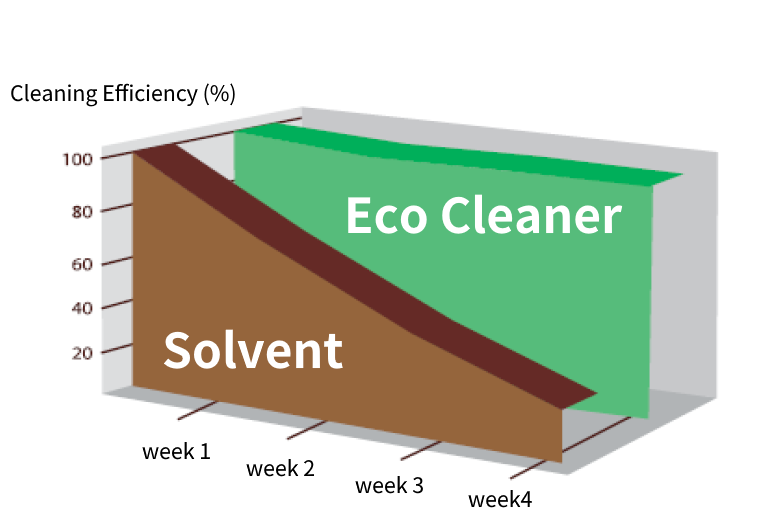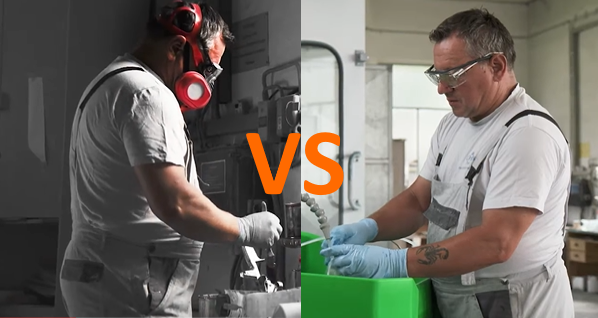What are the benefits of replacing hazardous solvents? No hazardous labels, low risk, longer use time.
Environmentally friendly cleaning agents are non-hazardous and flammable, making good use of factory space and reducing work safety risk~
When faced with the choice of low flash point solvent vs environmentally friendly cleaning agent, how to choose! ?
▲Comparison of solvents and environmentally friendly lotions
Do you want to get rid of toxic cleaning supplies in your factory?
Generally, the impression given by traditional factories is that they have various smells. If the factory is a metal processing production line, there will be stain removal oil (ex. Hexane) or environmentally friendly dry cleaning oil (ex. octane, nonane) pungent smell. If there is a spray paint or coating line, there will be a strong smell of thinner (ex. acetone or ethyl acetate) or even odorless paint remover (ex. methylene chloride). Although these low flash point solvents have good cleaning power, they clean very quickly and evaporate very quickly. However, when there is no ventilation system or when operating in a closed system, operators are also in intensive contact with solvents escaping in the factory. In the long term, it may cause symptoms such as dizziness, loss of coordination, weakness, asthma, difficulty breathing, skin irritation, dryness, eye irritation, and burning pain.
In addition to the smell, the solvent usage efficiency is also very poor!
Usually in painting factories, spray guns or some tools are soaked in solvents such as acetone or thinner. Because the cleaning efficiency is poor, the cleaning solvent must be replaced frequently. New environmentally friendly cleaning agent that removes paint, varnish and printing ink from spray guns, gravity cup guns, brushes, hoses and rollers. Through sedimentation and filtration steps, the service life can be extended to 20 times that of traditional diluent or gun cleaning water. Eco-friendly cleaners do not use traditional thinners but are used with cleaners with reduced hazardous substances, thus promoting a pleasant job, making storage easy and protecting the environment.
In the metal processing process, factories often use kerosene, stain removal oil or environmentally friendly dry cleaning oil to clean oil stains on the surface of workpieces. Through the compatibility of oil stains and solvents, the oil stains in the workpiece are gradually dissolved and separated to achieve a cleaning effect. However, because the cleaning power of the solvent relies on its own dissolving power, the cleaning power will decrease significantly as more oil is dissolved, until it is completely unusable and becomes a waste solvent waiting to be cleared and transported. Environmentally friendly cleaning agents peel oil off the surface of the workpiece and layer it with the cleaning agent. Therefore, through such an obvious separation mechanism, after the oil stain is removed, the cleaning tank fluid can be reused and maintains a certain cleaning power. It can still maintain about 80% of the cleaning power of new fluid after long-term use.

▲Environmentally friendly cleaning agent has long-lasting cleaning power
Whether it is hydrocarbon solvents used in metal processing processes or thinners in paint shops, if you are tired of inefficient substances, you have trouble The smell can cause health hazards. After trying environmentally friendly cleaning agents, you will find that there are more efficient and environmentally friendly alternatives! The following is a comparison between these two solvent products and environmentally friendly cleaning agents.
| Low flash point degreaser (metal processing plant) | Low flash point thinner (painting factory) | Environmentally friendly cleaning agent series | |
| The impact of increasing pollutant concentrations | The cleaning capacity will gradually reach saturation | The cleaning capacity will gradually reach saturation | Maintain stable cleaning power for a long time |
|
What substances can be removed by cleaning? Organic - stains, grease Inorganic-salts Inorganic - iron filings, dust |
Very good Poor Poor |
Paint - Good Varnish - Good Printing Ink - Good |
Very good Very good Good |
|
Material/substrate suitable for cleaning? Stainless steel Iron Aluminum Non-ferrous metals |
Very good Very good Very good Very good |
Very good Very good Very good Very good |
Very good Very good Very good Very good |
| Warning to Operator |  |
 |
 |
|
Health hazards-nerve agent system |
Toluene, xylene, trichlorethylene, benzene (hexane isomer, pentane, heptane, octane) |
Toluene, xylene, trichlorethylene | None |
| Harm the skin | Yes | Yes | None |
| Harm the liver | Methylene chloride, trichlorethylene, toluene, xylene, methanol, ethanol | Methylene chloride, trichlorethylene, toluene, xylene | None |
| damage to kidneys | Trichlorethylene, kerosene, gasoline/gasoline, hexane, heptane, toluene, xylene, alcohol | Toluene, xylene, trichlorethylene | None |
| Mutation and teratogenic genes | Toluene, benzene rings | Toluene | None |
| Carcinogenicity | Benzene Rings | - | None |
Advantages of environmentally friendly cleaning agents
Switch to water-based or environmentally friendly cleaners as a drop-in replacement for solvent-based parts cleaners and cleaning fluids and reap the immediate benefits: :
1. Reduce compliance requirements and liability risks - using non-hazardous cleaning systems and fluids means your business is safer. Environmentally friendly cleaners are almost always unhazard-labeled, so there are no labeling requirements under the CLP regulations*
*CLP Regulation: EU Regulations on Classification, Labeling and Packaging of Chemical Substances and Mixtures. The chemical classification and labeling system based on the United Nations GHS is incorporated into the REACH regulations.
2. Employee health and safety is significantly improved due to the non-hazardous nature of our cleaning fluids and water-based parts cleaners. VOC-free or reduced VOC cleaners do not pose the same health and safety risks as hazardous solvent-based cleaners
3. Restore lost space for storage and handling of hazardous materials, such as dedicated areas for ventilation
4. Reduce costs associated with dangerous goods transportation and personal protective equipment. No specialized transport is required and in many applications full personal protective equipment is not required
5. Use less cleaning products and have a longer service life without affecting performance. While solvent-based cleaners lose their cleaning power with repeated use, our smart cleaners are completely self-cleaning and maintain their cleaning performance over time
6. Reduce surface damage - Many of our cleaners offer powerful cleaning properties without damaging delicate surfaces
7. Reduce or completely eliminate indoor air pollution, hazardous waste and contaminated wastewater
8. Support decarbonization goals
(Part of the content is excerpted from https://www.bio-circle.co .uk/)
What should you consider when switching to an environmentally friendly cleaning agent?
1. Cleaning effect
The cleaning effect of environmentally friendly cleaning agents can also be evaluated through the original solvent-based cleaning agents. In addition to using simple oil test paper and water drop test, you can also use dyne pens, water drop angles or even specialized cleanliness testing equipment to judge the cleaning effect. The advantage of environmentally friendly cleaning agents here is their stable cleaning power, which does not significantly decrease with the increase of cleaning times like the cleaning power of solvents.
2. Drying time
Since the traditionally used solvents generally have low flash points and the liquid on the surface evaporates within 3-5 seconds, most factories are satisfied and accustomed to such drying speed and operation methods. The drying speed of environmentally friendly cleaning agents is relatively slow, and you may even need to set up an oven or hot water tank to speed up the drying speed.
3. Anti-rust requirements
In the traditional solvent cleaning process, there is little need to discuss the issue of rust throughout the entire process. However, if you switch to environmentally friendly cleaning agents, especially water-based products, you will encounter rust prevention issues. Usually, environmentally friendly cleaning agents are formulated with a short-term anti-rust effect, so during the short window period before the process, the anti-rust ability is still sufficient. However, if the anti-rust time is required for a long time, you still need to consider adding an additional water-based anti-rust agent to the cleaning bath liquid, or adding a layer of solvent-based anti-rust agent at the end to meet the anti-rust requirements for long-term storage.
4. Equipment adjustment
The original system may have been designed for solvent cleaning. There is a heated distillation design in which the used solvent is recovered and condensed before use. The heating temperature is about 70-90oC. If you want to switch to an environmentally friendly cleaning agent, the original system may not be usable. The reason is that environmentally friendly solvents generally have higher boiling points and cannot evaporate and recover in low-temperature environments. Therefore, the cleaning equipment may need to be appropriately adjusted, such as disabling condensation recovery equipment and replacing it with simple sedimentation filtration, and then reusing the cleaning fluid.
Sharing actual cases of replacing solvents:
1. Car intake manifold carbon deposit cleaning (replacing acetone)
Pollutants: oil carbon, coking oil, smoke
Environmental solution: replace acetone or gasoline with water-based renewable cleaners
Cleaning steps:
a. First remove the sealing strip and soak it in CB 100 ALU cleaning agent
b. After soaking, put it into a high-pressure cleaner and perform deep cleaning with CB 100 ALU at 45oC.
c. Rinse with clean water.
d. (Optional) Place the intake manifold into an ultrasonic vibrator for a second deep cleaning.
Video introduction:
2. Spark plug cleaning (replacing toluene)
Pollutants: oil carbon, coking oil, smoke
Environmental solution: replace toluene or xylene with water-based renewable cleaners
Cleaning steps:
a. Pour CB 100 ALU into the ultrasonic cleaning machine and put the spark plug in
b. Set the temperature at 60oC (need to preheat for 20 minutes), and set the cleaning time to 5-10 minutes
c. After cleaning, wipe with a cloth to confirm the cleaning effect and dry it or use a spray gun to completely dry it.
Video link:
3. Paint spray gun cleaning (replacing thinner)
Contaminants: coating materials
Environmental protection solution: replace low flash point diluent, acetone or ethyl acetate with non-hazardous label environmental cleaning agent
Cleaning steps:
a. Equipped with a circulating cleaning machine, pour the environmentally friendly cleaning agent into the machine (about 80L).
b. In line with the machine design, the first stage of precipitation and the second stage of filtration allow the cleaning agent to be recycled and reused.
c. (Not necessary) Use the existing thinner in the factory and perform final cleaning to meet standards.
Video link:
CONTACT US
Kelly Chemical Corporation
Electronics
TEL:(02)2762-1985 ext 11200
Online Message
Leave your contact information,
and we will get in touch with you soon.
Email Consultation
After receiving your email,
we will process it as soon as possible.send Email


